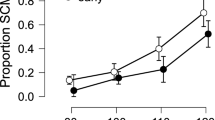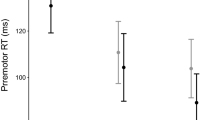Abstract
Recent experiments pairing a startling stimulus with a simple reaction time (RT) task have shown that when participants are startled, a prepared movement was initiated earlier in comparison to voluntary initiation. It has been argued that the startle acts to trigger the response involuntarily. However, an alternative explanation is that the decrease in RT may be due to stimulus intensity effects, not involuntary triggering. Thus the aim of the current investigation was to determine if RT simply declined in a linear fashion with increasing stimulus intensity, or if there was a point at which RT dramatically decreased. In the present experiment participants completed 50 active wrist extension trials to a target in response to an auditory stimulus of varying stimulus intensity (83–123 dB). The presented data show that RTs associated with a startle response are separate from stimulus intensity facilitated responses. Furthermore, this startle facilitation is more highly associated with sternocleidomastoid electromyographic (EMG) activity, rather than the EMG from the widely used startle response indicator muscle orbicularis oculi.



Similar content being viewed by others
References
Blumenthal TD (1996) Inhibition of the human startle response is affected by both prepulse intensity and eliciting stimulus intensity. Biol Psychol 44:85–104
Blumenthal TD, Cuthbert BN, Filion DL, Hackley S, Lipp OV, Van Boxtel A (2005) Committee report: guidelines for human startle eyeblink electromyographic studies. Psychophysiol 42:1–15
Brown P, Rothwell JC, Thompson PD, Britton TC, Day BL, Marsden CD (1991) New observations on the normal auditory startle reflex in man. Brain 114:1891–1902
Carlsen AN, Chua R, Inglis JT, Sanderson DJ, Franks IM (2003) Startle response is dishabituated during a reaction time task. Exp Brain Res 152:510–518
Carlsen AN, Chua R, Inglis JT, Sanderson DJ, Franks IM (2004a) Prepared movements are elicited early by startle. J Mot Behav 36:253–264
Carlsen AN, Chua R, Inglis JT, Sanderson DJ, Franks IM (2004b) Can prepared responses be stored subcortically? Exp Brain Res 159:301–309
Davis M (1984) The mammalian startle response. In: Eaton RC (ed) Neural mechanisms of startle behavior. Plenum, New York, pp 287–351
Kohfeld DL (1969) Effects of the intensity of auditory and visual ready signals on simple reaction time. J Exp Psychol 82:88–95
Levick WR (1973) Variation in the response latency of cat retinal ganglion cells. Vis Res 13:837–853
Luce RD (1986) Response times: their role in inferring elementary mental organization. Oxford University Press, New York
National Institute for Occupational Safety and Health (NIOSH) (1998) Publication No. 98–126: criteria for a recommended standard. CDC, Cincinnati
Rothwell JC, MacKinnon CD, Valls-Solé J (2002) Role of brainstem-spinal projections in voluntary movement. Mov Disord 17:S27–S29
Siegmund GP, Inglis JT, SandersonDJ (2001) Startle response of human neck muscles sculpted by readiness to perform ballistic head movements. J Physiol 535:289–300
Valls-Solé J, Rothwell JC, Goulart F, Cossu G, Muñoz E (1999) Patterned ballistic movements triggered by a startle in healthy humans. J Physiol 516.3:931–938
Wadman WJ, Denier van der Gon JJ, Geuze RH, Mol CR (1979) Control of fast goal-directed arm movements. J Hum Mov Stud 5:3–17
Woodworth RS (1938) Experimental psychology. Henry Holt, New York
Yeomans JS, Frankland PW (1996) The acoustic startle reflex: neurons and connections. Brain Res Rev 21:301–314
Acknowledgment
This work was supported by a grant from the Natural Sciences and Engineering Research Council of Canada awarded to I.M.F. and a Michael Smith Foundation for Health Research scholarship awarded to A.N.C.
Author information
Authors and Affiliations
Corresponding author
Rights and permissions
About this article
Cite this article
Carlsen, A.N., Dakin, C.J., Chua, R. et al. Startle produces early response latencies that are distinct from stimulus intensity effects. Exp Brain Res 176, 199–205 (2007). https://doi.org/10.1007/s00221-006-0610-8
Received:
Accepted:
Published:
Issue Date:
DOI: https://doi.org/10.1007/s00221-006-0610-8




